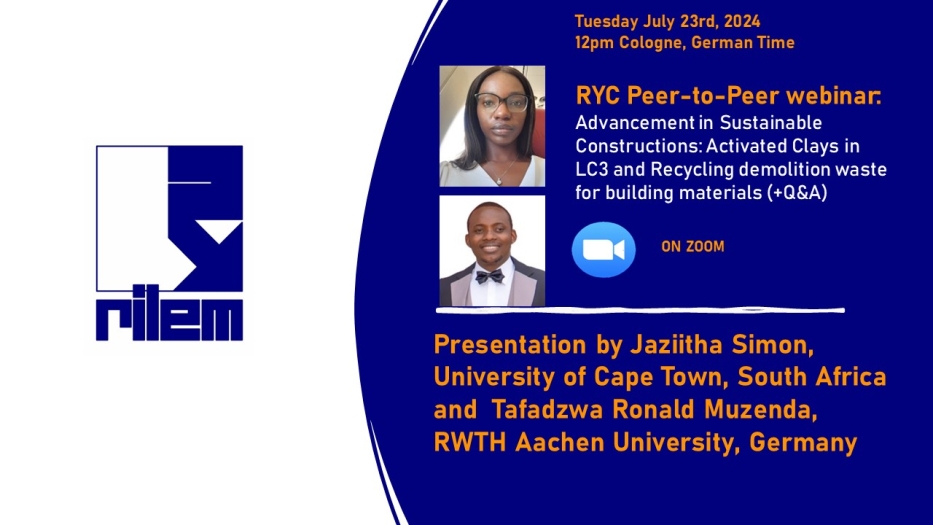Events calendar
Region : Sub-Saharan Africa

Peer-to-Peer Webinar: Advancement in Sustainable Constructions: Activated Clays in LC3 and Recycling demolition waste for building materials
The next Peer-to-Peer webinar will take place on Tuesday July 23rd, 2024 at 12pm Cologne Time and will be one hour long (2*20 minutes presentations + 15-minute interaction). The registration for this webinar is free.
Theme of the Peer-to-Peer Webinar: Advancement in Sustainable Constructions: Activated Clays in LC3 and Recycling demolition waste for building materials.
REGISTER FOR FREE HERE.
Speaker 1: Jaziitha Simon, University of Cape Town, South Africa
Title: The use of recycled construction and demolition waste in bricks and blocks production in the Global South
The surge in population and urbanization in the Global Southern countries has increased construction activities, generating substantial construction and demolition waste. While a portion of this waste is used in low-grade applications, the rest ends up in landfills. Previous research has predominantly explored the use of recycled aggregates in structural (wet-cast) concrete, overlooking low-strength (dry-cast) concrete used in bricks and blocks. This oversight is significant, as these concrete products are common building materials in these regions, consumes a considerable amount of cement and raw materials. Addressing this gap could enhance sustainable construction practices in the Global South.
Speaker 2: Tafadzwa Ronald Muzenda, RWTH Aachen University, Germany.
Title: Mechanical and thermal activation of natural kaolinitic clays for LC3: early and late-age performance.
Limestone calcined clay cements (LC3) have been shown to have great potential to reduce the carbon footprint of the cement and concrete industry while still yielding comparable mechanical and durability properties to ordinary Portland cement (OPC). The use of kaolinitic clays to produce calcined clays for LC3 by dihydroxylation (thermal activation) is now well-established. However, the phase composition of natural (kaolinitic) clays is always more than just kaolinite. Secondary phases such as quartz, iron (hydr)oxides, and other clay phases, for example from the illite or smectite group of mineral phases, are always present. The effect of these secondary phases on the physiochemical properties of the resulting calcined clays as well as their impact on the performance of CCLC needs to be understood. Additionally, a consideration of alternative activation methods will also further expand the adoption and use of LC3. In this webinar, we highlight the influence of secondary phases on the performance of calcined clays in LC3 at early and late age. We also give glimpses into the possibility of using mechanical activation to produce activated clays for use in LC3 with a total clinker substitution of 50%.
This webinar is brought to you by the RILEM Youth Council (RYC) and hosted by Angela Tawiah (Sub-Saharan Africa RYC representative).
No comment
Log in to post comment. Log in.





